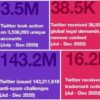Quantified self explainer FAQ: Uncover the fascinating world of tracking your personal data. This guide delves into the core principles, tools, and applications of quantified self practices, exploring the benefits and ethical considerations. From understanding the movement’s history to analyzing your own data, we’ll cover everything you need to know to navigate the quantified self journey.
This comprehensive FAQ explores the ‘quantified self’ movement, from its core principles and motivations to the practical tools and technologies used for data tracking. We’ll investigate the benefits and potential pitfalls, emphasizing the importance of ethical considerations in data collection and analysis. This guide equips you with the knowledge and insights to make informed decisions about incorporating quantified self practices into your life.
Introduction to Quantified Self
The quantified self (QS) movement is a growing trend focused on self-improvement through the systematic tracking and analysis of personal data. It emphasizes using technology to gain a deeper understanding of one’s own physical, mental, and behavioral patterns. This data-driven approach aims to reveal insights into personal well-being, optimize performance, and ultimately enhance quality of life.Core to the QS movement is the belief that understanding ourselves better allows us to make informed decisions about our health, habits, and overall lifestyle.
This pursuit of self-knowledge is driven by a desire for proactive management of personal development and a deep curiosity about the mechanics of the human body and mind.
Core Principles of Quantified Self
The quantified self movement is built on several core principles. These include the belief in the power of data, the emphasis on individualization, and the focus on practical application. The focus on individualization means that QS practitioners are less concerned with broad, generalized findings and more interested in understanding how their own bodies and minds react to different stimuli.
Motivations Behind Tracking Personal Data
QS practitioners are driven by various motivations. Some are interested in optimizing athletic performance, while others seek to improve their mental well-being. Many are driven by a desire to better understand their own biological rhythms and patterns. There’s a clear motivation to improve health, reduce stress, and ultimately, live more fulfilling lives. Others may simply be curious about the intricacies of their own bodies and minds.
Types of Data Collected by Quantified Self Practitioners
QS practitioners collect a wide array of data, encompassing physical, mental, and behavioral metrics. This diverse range of data allows for a comprehensive view of the individual’s overall well-being and patterns.
Methods of Measurement for Quantified Self Data
| Data Type | Common Methods of Measurement |
|---|---|
| Sleep | Wearable sleep trackers, sleep diaries, and sleep logs. These devices often monitor heart rate, movement, and sleep stages. |
| Activity Level | Fitness trackers, pedometers, and activity monitors measure steps taken, distance covered, and calories burned. |
| Nutrition | Food diaries, nutrition tracking apps, and wearable sensors that monitor caloric intake. Sophisticated devices can even track the nutritional content of meals. |
| Stress Levels | Stress trackers that monitor heart rate variability (HRV), and biofeedback techniques. These methods measure physiological changes associated with stress. |
| Mood and Emotions | Mood tracking apps, journaling, and questionnaires that assess emotional states. |
| Productivity | Time management tools, task management software, and apps that monitor time spent on various tasks. |
Tools and Technologies

The quantified self movement thrives on the availability of diverse tools and technologies. These tools enable individuals to meticulously track various aspects of their lives, from physical activity to sleep patterns and mental well-being. From simple wearable devices to sophisticated software platforms, the options for data collection and analysis are expanding rapidly. This empowers users to gain deeper insights into their personal dynamics and make informed decisions about their health and lifestyle.
Popular Tools and Technologies
Quantified self tracking relies heavily on a range of tools, each offering unique features and functionalities. Wearable devices like fitness trackers and smartwatches are extremely popular, offering continuous monitoring of physical activity, heart rate, and sleep. Mobile applications, often integrated with wearable devices, provide a platform for logging data, creating visualizations, and analyzing trends. Specialized software platforms offer more advanced analytical capabilities and often facilitate connections between various data sources.
Comparison of Data Collection Platforms
Different platforms cater to specific needs and preferences. Some platforms excel at integrating data from various wearable devices, while others focus on in-depth analysis of a single data source. The user interface and ease of use vary considerably between platforms, impacting the user experience and the long-term commitment to data collection. A well-designed platform should provide intuitive visualizations and analysis tools, facilitating a deeper understanding of collected data.
Data security and privacy are also crucial considerations when choosing a platform.
Hardware Solutions: Pros and Cons
Wearable fitness trackers, smartwatches, and other hardware solutions are increasingly sophisticated, providing real-time feedback and data collection capabilities. The benefits of these devices include continuous monitoring, often eliminating the need for manual data entry. However, the accuracy of measurements can vary based on factors like user positioning, device calibration, and environmental conditions. The cost of these devices can also be a barrier for some individuals.
Furthermore, issues with battery life and device maintenance can impact the long-term usability of the hardware.
Software Solutions: Pros and Cons
Software solutions offer a more comprehensive approach to data analysis and visualization. Many apps provide detailed reports and insights, helping users understand trends and patterns in their data. However, software often requires users to manually input data from various sources, which can be time-consuming and prone to errors. The cost of specialized software can also be a significant factor.
Moreover, the complexity of some software platforms might prove overwhelming for less technically inclined users.
Comparison of Quantified Self Apps
| App | Features | Data Analysis | Ease of Use |
|---|---|---|---|
| Fitbit | Heart rate tracking, sleep monitoring, step counting | Basic trend analysis, goal setting | Intuitive and user-friendly |
| Strava | GPS tracking of activities (running, cycling), social features | Detailed activity analysis, performance tracking | Straightforward for activity logging |
| MyFitnessPal | Food logging, calorie tracking, macro analysis | Detailed nutritional analysis, personalized plans | Simple for food logging, some complexity in analysis |
This table summarizes the key features of three popular quantified self apps. Each app offers different strengths in tracking specific aspects of daily life. The choice of app will ultimately depend on the individual’s specific goals and preferences.
Data Analysis and Interpretation
Once you’ve meticulously collected your quantified self data, the real journey begins: analyzing and interpreting it to glean meaningful insights. This process transforms raw numbers into actionable strategies for improvement and self-understanding. Effective analysis involves understanding various methods, recognizing patterns, and translating those patterns into practical steps. This section dives deep into the techniques and strategies for making your data work for you.
Common Methods for Analyzing Personal Data
A variety of methods are available for analyzing quantified self data. These range from simple calculations to more sophisticated statistical techniques. Choosing the right method depends on the type of data collected and the specific questions you’re trying to answer. Simple calculations like averages, maximums, and minimums can reveal trends. More advanced methods, such as linear regression, can identify correlations between different variables.
Interpreting Trends and Patterns in Collected Data
Identifying trends and patterns in your data is key to understanding the story your body is telling. Look for consistent increases, decreases, or fluctuations in your metrics over time. For example, if your sleep duration consistently decreases during the week and increases on weekends, you might infer a correlation between work stress and sleep quality. A critical aspect is to consider the context.
So, you’re curious about quantified self, and want to know more? My explainer FAQ is a great starting point, but did you know that tracking sleep patterns is a huge part of the quantified self movement? For example, Pokemon’s sleep app availability pokemon sleep app availability is a fun way to delve into the world of quantified self by monitoring sleep quality.
Ultimately, the quantified self explainer FAQ covers a lot of different facets, including how you can use data to improve your well-being.
Environmental factors, lifestyle changes, and other relevant variables can significantly influence the data. Don’t jump to conclusions; look for patterns that hold across multiple data points and are consistent with other observations.
Identifying Insights and Actionable Strategies Based on the Data
The ultimate goal of quantified self data analysis is to identify insights and formulate actionable strategies. This means connecting the dots between your data and your goals. If you notice a negative correlation between caffeine intake and focus levels, you might decide to reduce your caffeine consumption to see if it improves your productivity. This involves careful consideration of potential confounding factors and the need for a holistic approach.
You might also consider introducing changes in your lifestyle, diet, or routine. The important thing is to use the data to make informed decisions and create strategies tailored to your unique circumstances.
Visualizing Quantified Self Data
Visualizing your data using charts and graphs is an effective way to identify patterns and trends. This can make complex information easier to understand and communicate. Different chart types are suited to different types of data and analysis.
| Chart Type | Description | Suitable Data | Example |
|---|---|---|---|
| Line Chart | Displays data points connected by lines, showing trends over time. | Tracking daily steps, sleep duration, or heart rate over a week. | Visualizing changes in weight over several months. |
| Bar Chart | Compares different categories or groups using bars of varying heights. | Comparing sleep quality on weekdays vs. weekends, or comparing exercise intensity on different days. | Illustrating the number of hours spent on different activities in a week. |
| Scatter Plot | Shows the relationship between two variables by plotting data points on a graph. | Investigating the correlation between hours of exercise and calorie expenditure. | Identifying if there is a correlation between stress levels and blood pressure. |
| Pie Chart | Displays the proportion of different categories as slices of a circle. | Show the distribution of time spent on different activities, or the breakdown of sleep stages. | Representing the percentage of calories consumed from different food groups. |
Benefits and Applications: Quantified Self Explainer Faq
The quantified self movement isn’t just about collecting data; it’s about leveraging that data to gain a deeper understanding of ourselves and optimize our lives. This understanding empowers us to make informed decisions, identify patterns, and ultimately improve our well-being, productivity, and overall experience. The benefits extend far beyond personal use, impacting professional life as well.Quantified self data offers a unique perspective, enabling us to track and analyze our habits, responses, and performance in ways that traditional methods often miss.
This personalized approach allows us to fine-tune our actions and achieve desired outcomes with greater precision. From optimizing sleep patterns to boosting athletic performance, the applications are numerous and constantly evolving.
Potential Benefits of Quantified Self Practices
Quantified self practices, when implemented effectively, can significantly enhance various aspects of life. The key is to choose metrics relevant to individual goals and to analyze the data thoughtfully. It’s not just about the numbers; it’s about the insights they reveal.
So, you’re digging into quantified self explainer FAQs? That’s cool! Understanding how to track your own data is important, but for secure AI applications, tools like secure gen ai with prisma access browser aag are essential. These systems ensure your data is handled properly and safely, which ultimately helps you get more accurate and useful results from your quantified self efforts.
- Improved Health and Wellness: Tracking metrics like sleep duration, heart rate variability, and activity levels allows individuals to identify patterns in their health and make adjustments to improve sleep quality, stress management, and overall well-being. This personalized approach can lead to more proactive and effective health management strategies.
- Enhanced Fitness Performance: Quantified self tools can help athletes and fitness enthusiasts monitor their workouts, track progress, and optimize training routines. Data on pace, distance, recovery time, and other metrics can inform adjustments in training programs, leading to improved performance and reduced risk of injury. For example, a runner might track their pace during different workouts to identify optimal training strategies.
- Increased Productivity and Focus: By tracking time spent on different tasks, identifying peak performance times, and recognizing patterns in distractions, individuals can optimize their work schedules and improve focus. This data-driven approach to productivity can lead to significant improvements in efficiency and task completion rates. Someone might find they are most productive in the morning and use that knowledge to schedule demanding tasks.
- Enhanced Decision Making: Quantified self data provides a deeper understanding of personal preferences, strengths, and weaknesses. This insight allows for more informed decisions about lifestyle choices, career paths, and personal development, ultimately leading to a more fulfilling life. For instance, tracking dietary intake and energy levels can help identify food sensitivities or nutritional needs, which can be beneficial for weight management or athletic performance.
Applications in Different Aspects of Life
The applications of quantified self extend far beyond personal health and fitness. The insights gained can be invaluable in various areas of life.
- Personal Well-being: Monitoring mood, stress levels, and sleep quality can provide valuable insights into emotional patterns and trigger points. This knowledge empowers individuals to develop coping mechanisms and strategies for maintaining emotional well-being. For example, a person might notice a correlation between social media use and anxiety and adjust their social media consumption accordingly.
- Professional Development: Quantified self practices can help professionals identify patterns in productivity, understand their strengths and weaknesses in different work environments, and tailor their approaches to optimize performance. This allows for targeted development and growth in their professional careers. A sales representative could track their sales calls to understand which strategies yield the highest conversion rates.
- Educational Settings: Tracking student performance, engagement levels, and learning styles can inform teachers and educators about effective teaching strategies. This allows for more personalized learning plans and interventions, leading to better educational outcomes. A student might track their reading comprehension progress to understand their strengths and weaknesses in different subject areas.
Quantified Self and Personal Well-being
Quantified self data provides a personalized lens through which to view personal well-being. By tracking various metrics, individuals can gain insights into their habits, behaviors, and responses, allowing them to make informed choices to enhance their overall well-being. The key is to focus on meaningful metrics relevant to individual goals.
- Stress Management: Tracking stress levels and identifying triggers can empower individuals to develop coping strategies and create a more balanced lifestyle. For example, someone might notice a correlation between evening meetings and heightened stress levels and reschedule or adjust their workload accordingly.
- Sleep Optimization: Monitoring sleep patterns and identifying factors that affect sleep quality allows individuals to create optimized sleep routines and environments. Understanding the impact of caffeine or specific foods on sleep can be crucial for a more restful night’s sleep.
- Improved Mood Regulation: Tracking mood changes and identifying patterns can help individuals develop strategies for managing emotional well-being. This might involve recognizing situations or activities that lead to negative mood swings and developing ways to counteract these patterns.
Applications in Professional Settings
Quantified self data can be effectively used in various professional settings, helping individuals and organizations optimize performance and achieve greater success.
- Productivity Enhancement: Tracking work patterns, identifying peak performance times, and analyzing time spent on various tasks allows professionals to optimize their work schedules and boost productivity. This data-driven approach to workflow can improve task completion rates and efficiency.
- Performance Improvement: Analyzing performance metrics and identifying areas for improvement allows professionals to focus on targeted development and skill enhancement. For instance, tracking customer interactions and feedback can help sales teams identify areas where they need to improve their communication and customer service skills.
- Team Dynamics: Understanding team dynamics and individual contributions can help optimize team performance and collaboration. By tracking communication patterns and individual work styles, teams can identify areas for improvement and enhance their overall effectiveness.
Benefits Across Different Areas
| Area | Potential Benefits |
|---|---|
| Health | Improved sleep quality, stress management, early disease detection |
| Fitness | Enhanced performance, injury prevention, optimized training |
| Productivity | Increased efficiency, optimized schedules, improved focus |
| Well-being | Mood regulation, stress reduction, improved emotional health |
| Professional Development | Performance enhancement, targeted skill development, improved team dynamics |
Ethical Considerations
The quantified self movement, while empowering, raises important ethical considerations. As we delve deeper into self-tracking and data analysis, navigating these concerns is crucial for responsible practice and widespread adoption. The potential for misuse, particularly in data privacy and security, must be addressed. Understanding the implications of quantified self data on personal identity is also paramount.
Data Privacy and Security
Data privacy and security are paramount in the quantified self movement. Individuals must be assured that their personal data is collected, stored, and used responsibly. Robust security measures are essential to prevent unauthorized access and breaches. This includes encryption, access controls, and regular security audits. Transparency about data handling practices and the potential risks associated with data breaches should be clearly communicated to individuals.
Examples include secure cloud storage solutions, strong passwords, and two-factor authentication. Furthermore, individuals should have control over their data, including the right to access, modify, and delete their data.
Informed Consent
Informed consent is fundamental to ethical data collection in quantified self practices. Individuals must be fully aware of how their data will be collected, used, and potentially shared. This includes a clear explanation of the purpose of data collection, potential risks, and benefits. Consent forms should be easily accessible and understandable. Furthermore, individuals should have the option to withdraw their consent at any time without penalty.
This demonstrates respect for autonomy and allows individuals to make informed choices about their data. A crucial aspect is providing detailed information about how the collected data might be used for research or analysis, ensuring informed choices about data sharing and potential consequences.
So, you’re diving into the quantified self explainer FAQ? It’s all about tracking your data, right? Well, while you’re analyzing your personal metrics, consider unleashing your creative side with these one-day deals on 3D printers and accessories! This could even add a whole new dimension to your self-tracking. Ultimately, whether you’re crafting intricate models or meticulously logging your sleep patterns, the quantified self explainer FAQ can help you understand your data better.
Implications on Personal Identity
Quantified self data can significantly influence how individuals perceive themselves. Data visualizations, particularly when focused on specific metrics like weight or sleep patterns, can potentially shape self-perception and lead to self-comparison. Individuals might develop anxieties or insecurities if they perceive their metrics as falling short of desired standards. Moreover, the potential for self-objectification needs to be acknowledged.
Individuals should be encouraged to critically evaluate the impact of their data on their self-image. This includes focusing on progress and personal growth, rather than solely on comparisons or perceived deficits. Data should be viewed as a tool for understanding, not as a measure of inherent worth.
Ethical Guidelines and Best Practices
The responsible use of quantified self data requires adherence to ethical guidelines. A clear understanding of these guidelines is essential for individuals and organizations involved in quantified self practices. These guidelines should encompass data privacy, security, and informed consent. Appropriate use cases, limitations, and future directions must be considered.
| Ethical Guideline | Best Practice |
|---|---|
| Data Minimization | Collect only the necessary data, avoid excessive collection. |
| Data Security | Implement strong encryption and access controls. Regularly audit security protocols. |
| Data Anonymization | De-identify data where possible to protect individual privacy. |
| Transparency | Clearly communicate data collection and usage policies to individuals. |
| Informed Consent | Obtain explicit consent from individuals before collecting or using their data. |
| Data Retention | Establish clear data retention policies to prevent unnecessary storage. |
Common Challenges and Solutions
Embarking on a quantified self journey can be incredibly rewarding, but it’s not without its hurdles. Understanding common challenges and developing effective strategies for overcoming them is crucial for long-term success. This section delves into obstacles encountered by practitioners and provides actionable solutions, empowering you to navigate the quantified self landscape with confidence.Quantified self practices, while offering valuable insights, can sometimes become overwhelming or unsustainable if not approached strategically.
This section addresses common pitfalls and provides guidance on how to avoid them, ensuring a positive and productive experience.
Sustaining Motivation and Consistency
Maintaining motivation and consistency in quantified self practices is a significant challenge. The initial enthusiasm can wane as the novelty fades, leading to inconsistencies in data collection. Understanding the reasons behind this is crucial for developing sustainable routines.
- Establishing clear goals and meaningful metrics: Vague goals are less motivating than specific ones. Defining clear objectives and choosing metrics that resonate with personal values and aspirations are essential for sustained motivation. For instance, instead of “exercise more,” set a goal of “running 3 times a week for 30 minutes.” The clarity and measurability of this goal make it more likely to be achieved and sustained.
- Integrating data collection into daily routines: Effortless integration is key to consistency. Quantified self practices should seamlessly blend into existing daily routines, minimizing disruption and maximizing adherence. For example, tracking steps using a smartwatch that automatically syncs with a phone app can make data collection more effortless.
- Finding support and accountability: Sharing quantified self experiences with friends, family, or online communities can provide encouragement and support. Accountability partners can help stay on track and offer motivation when motivation wanes. Join a forum, or find a friend who is also interested in quantified self.
Data Overload and Analysis Paralysis
Collecting vast amounts of data can lead to analysis paralysis, hindering the ability to extract meaningful insights. Overwhelmed by the sheer volume of information, practitioners may struggle to interpret data effectively.
- Prioritizing key metrics: Instead of tracking every aspect of daily life, focus on a manageable set of metrics that directly align with personal goals. For instance, if weight loss is the primary goal, track calorie intake, exercise duration, and sleep quality. This focused approach makes data analysis more manageable.
- Employing data visualization tools: Transforming raw data into visually appealing charts and graphs can significantly enhance comprehension. Interactive dashboards and visualization tools can help to spot trends, patterns, and anomalies more readily.
- Developing clear interpretation frameworks: Establish clear criteria for interpreting data, based on personal goals and benchmarks. For example, if the goal is improved sleep, use sleep tracking data to identify patterns and make adjustments to improve sleep hygiene. This focused approach avoids the pitfall of analysis paralysis.
Data Privacy and Security Concerns
Protecting personal data is paramount in the quantified self movement. Data breaches and misuse of personal information can have serious implications.
- Choosing secure and reliable platforms: Selecting platforms with robust security measures is essential. Prioritize platforms with end-to-end encryption and transparent privacy policies. Understand how your data is stored and handled.
- Implementing data anonymization strategies: Anonymizing data wherever possible minimizes risks associated with data breaches. This involves removing identifying information before sharing or analyzing data. For example, instead of tracking exact location, track general movement zones.
- Regularly reviewing privacy settings: Understanding and adjusting privacy settings on different platforms is vital for maintaining control over personal data. Be proactive in reviewing these settings to ensure they align with your privacy preferences.
Table: Common Challenges and Solutions, Quantified self explainer faq
| Challenge | Solution |
|---|---|
| Sustaining Motivation and Consistency | Establish clear goals, integrate data collection into routines, find support and accountability. |
| Data Overload and Analysis Paralysis | Prioritize key metrics, employ data visualization tools, develop clear interpretation frameworks. |
| Data Privacy and Security Concerns | Choose secure platforms, implement data anonymization strategies, regularly review privacy settings. |
Case Studies and Examples
Quantified self practices are no longer confined to the realm of tech enthusiasts. Increasingly, individuals across diverse fields are leveraging these practices to gain insights into their bodies, behaviors, and performance, leading to tangible improvements in their lives. This section explores real-world examples of quantified self strategies, showcasing their effectiveness and impact.
Real-World Applications of Quantified Self
Quantified self practices have broad applicability. From athletes optimizing their training regimes to individuals managing chronic conditions, the use of data to inform decisions is becoming increasingly common. The examples below demonstrate the variety of ways individuals use quantified self data.
- Athletes and Performance Enhancement: Many athletes use wearable technology to monitor metrics like heart rate variability, sleep patterns, and training load. This data allows them to fine-tune their training schedules, optimize recovery, and prevent injuries. For instance, a professional cyclist might use a device to track their cadence and power output during training rides, enabling them to tailor their workouts to maximize performance.
- Chronic Condition Management: Individuals with conditions like diabetes or epilepsy use quantified self data to understand the factors influencing their health. By meticulously tracking glucose levels, medication adherence, or seizure activity, they gain valuable insights for better self-management and potentially adjust their lifestyle or medication regimen accordingly. This proactive approach empowers individuals to better control their health and well-being.
- Productivity and Time Management: The ability to track time spent on various tasks and activities allows individuals to identify time-wasting habits and optimize their work flow. For example, a software developer might use a time-tracking app to monitor their daily work hours, identifying periods of peak productivity and patterns that indicate potential inefficiencies.
Successful Implementations of Quantified Self Strategies
Quantified self strategies can yield positive results when implemented correctly. A structured approach to data collection, analysis, and interpretation is crucial for achieving meaningful outcomes. Effective strategies often involve setting clear goals, using appropriate tools, and consistently tracking relevant metrics.
- Goal Setting and Tracking: A crucial aspect of successful implementation is setting specific, measurable, achievable, relevant, and time-bound (SMART) goals. Tracking progress toward these goals provides motivation and accountability. For example, an individual aiming to improve their sleep quality might set a goal to achieve 8 hours of sleep nightly for a week, then analyze sleep tracking data to understand what factors might be contributing to achieving or failing to achieve this goal.
- Tool Selection and Data Quality: Choosing the right tools for data collection is essential. Accuracy and reliability are paramount. An athlete might choose a heart rate monitor that aligns with their training needs, ensuring accurate data capture. Consistency in data collection practices is also vital to obtain reliable data.
Using Quantified Self Data for Research
Quantified self data has become increasingly valuable for research purposes. The large datasets generated by individuals offer insights into human behavior and health that are difficult to obtain through traditional methods. This allows researchers to explore correlations and patterns in a way that wasn’t previously possible.
- Exploring Correlations: Quantified self data enables the investigation of relationships between various factors. For example, researchers can analyze data from participants to investigate the correlation between sleep duration and cognitive performance. The data generated can inform new research questions and lead to a more profound understanding of human behavior.
- Developing New Interventions: Researchers can use quantified self data to develop interventions that address specific issues. For instance, by analyzing the sleep patterns of individuals, researchers might identify patterns that could be used to develop strategies to improve sleep quality.
Case Study Table
| Case Study | Quantified Self Strategy | Outcome |
|---|---|---|
| Improving Sleep Quality | Tracking sleep duration, sleep quality, and environmental factors | Improved sleep duration and reduced sleep disturbances |
| Optimizing Exercise Regimen | Monitoring heart rate, activity levels, and recovery | Enhanced athletic performance and reduced injury risk |
| Managing Chronic Pain | Tracking pain levels, activity levels, and stress levels | Improved pain management and reduced reliance on medication |
Visualizations and Representations

Transforming raw quantified self data into meaningful insights often hinges on effective visualizations. Visual representations, whether graphs, charts, or dashboards, can reveal patterns, trends, and correlations that might be hidden in spreadsheets or tables. This section explores various visualization techniques to effectively communicate quantified self data.
Effective Visualization Techniques
Visualizations are crucial for understanding quantified self data. Choosing the right type of graph or chart can dramatically impact the clarity and impact of the message conveyed. From simple line graphs to complex interactive dashboards, the goal is to present information in a way that is easily understood and allows for quick identification of key patterns.
Examples of Visualizations for Different Data Types
Different types of quantified self data lend themselves to different visualization styles. For instance, tracking daily steps using a line graph allows for immediate identification of activity patterns over time. A bar chart can be used to compare sleep duration across days, while a scatter plot can be used to correlate sleep duration with exercise. The choice of visualization depends on the question being asked and the nature of the data.
- Line Graphs: Ideal for tracking changes over time. A line graph displaying daily step counts over a week reveals trends in activity levels. Variations in step count can be easily identified, highlighting days with unusually high or low activity.
- Bar Charts: Useful for comparing different categories or values. A bar chart comparing sleep duration on weekdays and weekends allows for a clear visual comparison of sleep habits across different days.
- Scatter Plots: Excellent for identifying correlations between two variables. A scatter plot showing the correlation between daily steps and heart rate variability reveals any potential patterns. A clear trend, if present, is easily spotted.
- Histograms: Ideal for visualizing the distribution of a single variable. A histogram of heart rate readings throughout the day illustrates the frequency of different heart rate ranges. This helps to understand the typical heart rate patterns and any outliers.
Creating Impactful Visualizations
To create impactful visualizations, focus on clarity and simplicity. Use clear labels, meaningful titles, and appropriate scales. Avoid clutter by using a limited color palette and choosing a suitable font size. Interactive elements, like tooltips or zooming features, can enhance the user experience and provide more detailed information on demand.
Designing Visually Appealing Dashboards
A dashboard provides a comprehensive overview of various quantified self metrics. A well-designed dashboard should be organized logically, with each section focused on a specific aspect of the data. Use different chart types to represent different data points. Emphasize important trends or patterns with color-coding and highlighting. Consider adding interactive elements for deeper analysis.
Illustrating Data Progression Over Time
Visualizing the progression of quantified self data over time allows for a clear understanding of long-term trends and patterns. For example, a series of line graphs can show the evolution of sleep duration, sleep quality, or exercise habits over months or years. Highlighting key milestones or changes in lifestyle can make these visualizations even more informative. For example, a graph showing improvement in sleep quality following a change in bedtime routine can illustrate the positive impact of a particular intervention.
Conclusion
In conclusion, quantified self practices offer a powerful approach to understanding and optimizing various aspects of life, from health and fitness to productivity and well-being. By understanding the tools, techniques, and ethical considerations, you can embark on a personalized journey of self-discovery and improvement. This FAQ provides a robust foundation for exploring the world of quantified self. Remember, responsible data collection and analysis are key to maximizing the benefits of this powerful movement.






